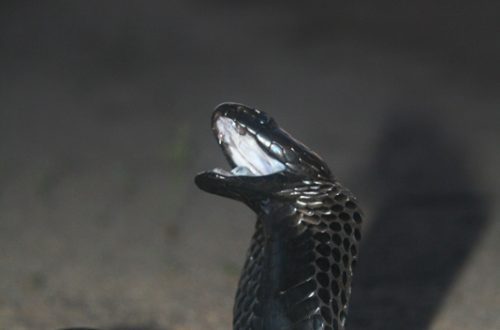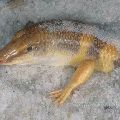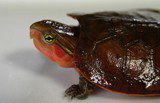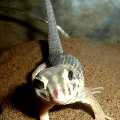
Skink gecko
Skink geckos (lat. Teratoscincus) are valued by terrariumists for their beautiful coloration. However, as a pet, this lizard is not very popular due to its circadian rhythms. It is active mainly in the dark, so it is not very convenient to watch the skink gecko. And although this genus includes only 6 species, it is sometimes separated into a separate subfamily Teratoscincinae. Its most typical representative is the skink gecko Teratoscincus scincus. This reptile is called the largest-eyed lizard in Russia. The eyes of a gecko have an amazing feature in the dark to shine with a ruby shine.
Contents
Classification
Kingdom: Animals
Type: Chord
Subtype: Vertebrates
Class: Reptiles
Order: Scaly
Suborder: Lizards
Family: Geckos (Gekkonidae)
Subfamily: Teratoscincinae
Genus: Skink geckos
Species: Skin Gecko Teratoscincus scincus
Appearance
The skink gecko is not a very large lizard with a wide and high head, decorated with large protruding eyes. The approximate dimensions of the reptile are 16-20 cm. Its body is rather short and awkward, covered with almost identical large rounded scales, as if overlapping each other and thus resembling tiles. On the head, these scales become noticeably smaller and take the form of polygons. Only the shields near the corners of the mouth are more aesthetic and correct. The color of the skink gecko is quite diverse – yellowish or greenish with a gray tint on top, rusty-red along the upper side and lilac-smoky at the bottom. On the back there is a pattern of several dark stripes or more chaotic stains and spots of coffee color, and the same dark stripe runs along each side, and the abdomen is almost white, only a lemon tint appears on the throat. Males have dark spots on their hind legs, and a large genital pouch is noticeable near the tail. Females are generally more subdued in coloration. The short tail of skink geckos is covered with large nail plates and is a rather fragile part of their body. Lizards easily discard it in the event of a predator attack. And the scales on the tail are also fragile, easily peeling off when touched carelessly. Skink geckos also lack the femoral and preanal pores found in some other reptiles. And the main distinguishing feature can be called eyes glowing with ruby light in the dark – this feature was immediately noted by observers of the night life of these lizards. The average lifespan of a skink gecko is about 10 years. And he becomes sexually mature when he reaches one and a half years.
Among some genera of reptiles, there are very similar characteristics. So the skink gecko has such relatives. In particular, this is a comb-toed gecko living in Russia, similar to the skink in color and manner of movement on outstretched paws. True, he is much smaller and slimmer than our hero, and in addition he has not a brittle, but a tenacious tail. And another similar relative is the bare-toed gecko, with which the skink is also sometimes confused.
Distribution and habitation
All types of skink geckos are common in the sultry and desert areas of Central Asia, Iran, Pakistan, in the east of the United Arab Emirates, in Qatar and Oman. On the territory of Russia, these reptiles can be found in the south of Kazakhstan – this area is typical just for the common gecko. The territories of Mongolia and the border regions of China belong to the range of the Przewalski skink gecko. Another species – the Bedriagi gecko – prefers the central Asian countries of the equatorial belt – Iran and Afghanistan. Approximately in the same areas some other representatives of the genus live. All skink geckos are not afraid of the desert, but rather tend to sandy soils with sparse vegetation and only occasionally wander onto dense clay soils and loess plateaus adjacent to the sands.
Behavior and lifestyle
 Skink geckos are terrestrial lizards, burrowing deep enough in the sands, reaching a meter of burrow. They are active at night, in the mornings or evenings, when the sun has not yet risen or has already disappeared. These loners are territorial and prefer not to violate the boundaries of other people’s plots. Only during the mating season can two males clash in a fight. Skink geckos can squeak and make a characteristic crackle with the help of scales on their tail, designed to distract the attention of a predator and serve as a warning signal to other reptiles. They leave for wintering in autumn at different times, depending on the surrounding climate in a particular area. And in March-April, the first individuals are already emerging from their winter stupor. However, the skinny gecko prepares carefully for winter. He digs a deep passage in the sand at an angle, climbs inside, reaching the wet layers of sand, and closes the entrance to it with the same sand plug. So the lizard not only hibernates, but also spends the daytime, going hunting only at night.
Skink geckos are terrestrial lizards, burrowing deep enough in the sands, reaching a meter of burrow. They are active at night, in the mornings or evenings, when the sun has not yet risen or has already disappeared. These loners are territorial and prefer not to violate the boundaries of other people’s plots. Only during the mating season can two males clash in a fight. Skink geckos can squeak and make a characteristic crackle with the help of scales on their tail, designed to distract the attention of a predator and serve as a warning signal to other reptiles. They leave for wintering in autumn at different times, depending on the surrounding climate in a particular area. And in March-April, the first individuals are already emerging from their winter stupor. However, the skinny gecko prepares carefully for winter. He digs a deep passage in the sand at an angle, climbs inside, reaching the wet layers of sand, and closes the entrance to it with the same sand plug. So the lizard not only hibernates, but also spends the daytime, going hunting only at night.
The skink gecko hunts mainly for insects and their larvae, which it finds on the surface of the earth. It is interesting to watch its movement: this reptile runs fast enough, raising its body high on outstretched legs and lifting up its tail, becoming more like some small animal. However, the skink gecko still does not go far from its shelter. True, you are unlikely to see him during the day, except that you can find traces of stars from paws in the sand. But at night with a lantern, people easily catch these reptiles, as the bright light blinds them and brings them into a state of short-term stupor, sufficient for capture. But even if the gecko is captured, he still has the opportunity to escape, leaving the enemy only a wriggling and crackling tail. Zoologists have noticed that if such a tail is placed in an aviary with other geckos, they will immediately raise a panic because of the possible danger of which it is a sign. These reptiles generally easily part with this part of their body and quickly restore it to its original form. And they molt amazingly, in nature climbing into holes for this. But in the nursery, zoologists managed to see how skink geckos capture the skin lagging behind the body, tear it off and eat it. And from the limbs they remove the scales, like a glove. In captivity, skink geckos get used to people gradually. And when they get used to it, they begin to boldly take the food offered with the help of tweezers, and are even able to climb into the palm of their hand to warm themselves.
Food
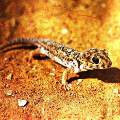 Skink geckos, like other lizards, feed on various insects and small invertebrates that they manage to catch. These are, for example, dark beetle beetles or May beetles, sometimes an ant or some kind of arachnid can be prey. And in terrariums, it is recommended to give the lizard house and banana crickets, various cockroaches, flour worms bred or purchased with their own hands, zoophobas and even small newborn mice – but not very often. Young animals should be fed in the same way as adult lizards, only in slightly smaller portions. Feeding regimen at least once every two days, but daily is better. And of course, you should not leave your pet without water, which also needs to be changed every day. Mineral “Borjomi” can be occasionally mixed with ordinary water, and once a month it is necessary to fortify the diet of skink geckos with various additives and top dressing for reptiles.
Skink geckos, like other lizards, feed on various insects and small invertebrates that they manage to catch. These are, for example, dark beetle beetles or May beetles, sometimes an ant or some kind of arachnid can be prey. And in terrariums, it is recommended to give the lizard house and banana crickets, various cockroaches, flour worms bred or purchased with their own hands, zoophobas and even small newborn mice – but not very often. Young animals should be fed in the same way as adult lizards, only in slightly smaller portions. Feeding regimen at least once every two days, but daily is better. And of course, you should not leave your pet without water, which also needs to be changed every day. Mineral “Borjomi” can be occasionally mixed with ordinary water, and once a month it is necessary to fortify the diet of skink geckos with various additives and top dressing for reptiles.
Reproduction
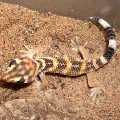 Experts are unlikely to discover any new information in the reproduction of skink geckos. It is an oviparous reptile. They reach puberty at 1 years of age, when the length of the body becomes about 5 cm. Moreover, in some cases, lizards are able to share their shelter with other creatures, for example, a large ground beetle, dung beetles, or even jerboas and gerbils. Peak mating season for skink geckos occurs in mid-spring, and laying is done in early summer. Pregnant female lizards walk for about a month. In a clutch of various types, there can be from 10 to 1 small, but with hard calcareous shells of eggs. Sometimes people happened to find common clutches of several females in one nest. But, one way or another, the warm and dry atmosphere of the hole leads to the fact that after 4-2 months small geckos are born, only 5-3 cm in size. insects. And young animals need calcium, at least every other day. In good conditions, a female can bring offspring 5-6 times a year.
Experts are unlikely to discover any new information in the reproduction of skink geckos. It is an oviparous reptile. They reach puberty at 1 years of age, when the length of the body becomes about 5 cm. Moreover, in some cases, lizards are able to share their shelter with other creatures, for example, a large ground beetle, dung beetles, or even jerboas and gerbils. Peak mating season for skink geckos occurs in mid-spring, and laying is done in early summer. Pregnant female lizards walk for about a month. In a clutch of various types, there can be from 10 to 1 small, but with hard calcareous shells of eggs. Sometimes people happened to find common clutches of several females in one nest. But, one way or another, the warm and dry atmosphere of the hole leads to the fact that after 4-2 months small geckos are born, only 5-3 cm in size. insects. And young animals need calcium, at least every other day. In good conditions, a female can bring offspring 5-6 times a year.
Reproduction of skink geckos in a terrarium is also possible, and this species is bred quite well. True, he first needs to arrange an artificial wintering, and then pick up the laid eggs in time. Interestingly, in nature, incubation occurs in a dry and warm climate, and in an artificial incubator it is recommended to create a higher humidity.
Interesting Facts
– The amazing property of skink gecko scales to easily peel off from the body has already been mentioned. On the one hand, this means the defenselessness of the lizard, on the other hand, it gives it a unique ability to absorb oxygen directly through the skin.
– For their bulging round eyes, these lizards are also called toad-eyed geckos.
– At night, geckos can be attracted to the light from the fire. Settling at a distance, this lizard carefully look at the light source and sometimes licks its eyes with its tongue, as if “wiping” them.
– Life in the desert determines some structural features of the organism of skink geckos. Nighttime activity is associated with lower air and sand temperatures. Day stay in shelters – salvation from the heat. The yellowish color performs a masking function among similar shades of desert nature. Convex, located closer to the top of the head, the eyes help to better navigate the thickness of the sand. Microscopic hairs or brushes on the inner surface of the legs allow you to move faster on loose substrate.
– The elongated scales around the bulging eyes of the skink gecko resemble eyelashes, which, combined with the meek expression of the muzzle, creates an amazing impression.
For home maintenance, it is not very suitable because in everyday life it manifests itself as a too gentle creature. A male and female skink gecko in the same space can easily injure each other even during mating. Therefore, after mating, they try to seat them as quickly as possible and generally keep them one by one. These lizards have many interesting features. And one of them is the ability to make sounds … with a tail. The fact is that the gecko’s tail is covered with nail plates, which, when it moves, rub against each other, and a characteristic crack occurs. About other unique characteristics of the reptile – in the relevant sections of the article.
Sources of
http://ru.wikipedia.org/
http://www.zooclub.ru/
http://www.ecosystema.ru/
http://www.floranimal.ru/
http://www.VitaWater.ru/
http://house-fauna.narod.ru



